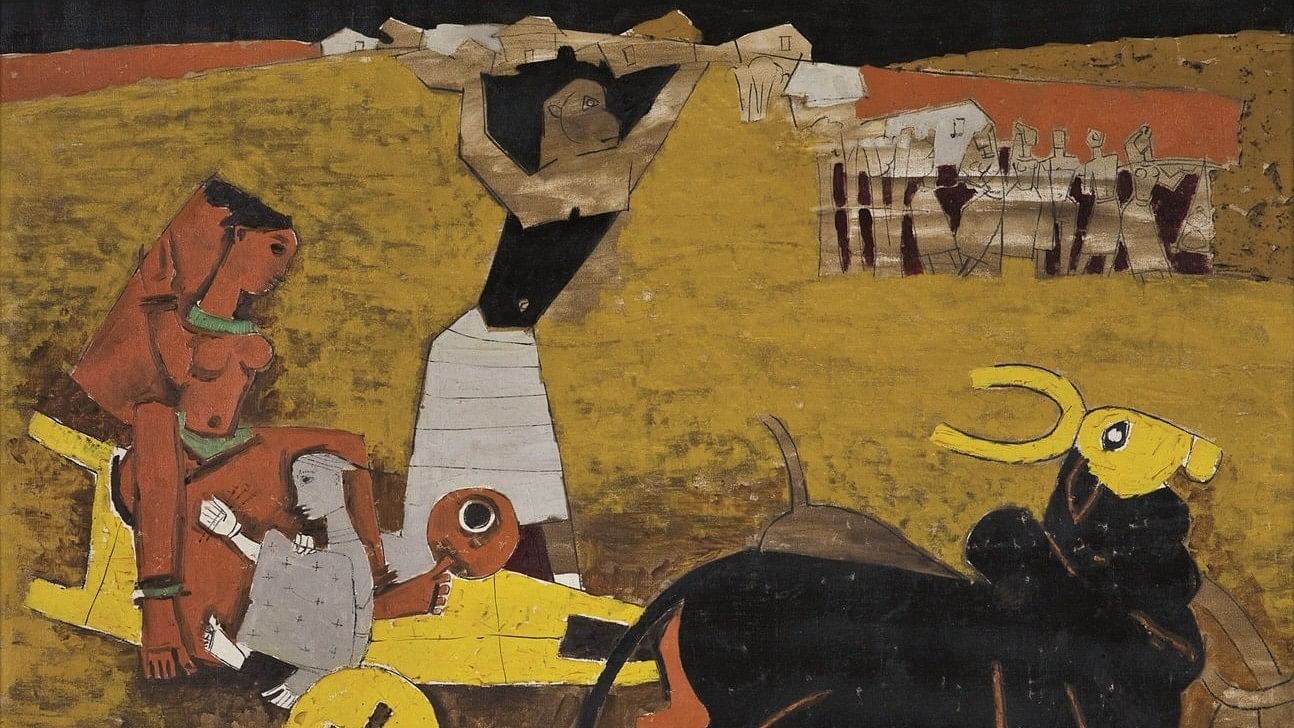
'Yatra'
Credit: KNMA
Renowned artist and maverick Maqbool Fida Husain’s ‘The Rooted Nomad’, a dual format event — part exhibition, part immersive — is garnering much attention at the Magazzini del Sale, Venice, Italy.
Echoing this year’s Venice Biennale’s theme of ‘Foreigners Everywhere’, the pathbreaking show on India’s most celebrated albeit controversial artist captures his itinerant and adventurous spirit through his worldly travels until his death in 2011, aged 95.
Running parallel to the 60th Venice Biennale, The Rooted Nomad also showcases Husain’s myriad iterations of ‘yatra’ or journey, using the metaphor both as an artistic calling as well as a process for transformation.
The compelling migration theme — so pertinent in today’s fraught geopolitical landscape — makes visitors reflect on the universal ideas of mobility, migration, moving across borders and beyond fixed boundaries.
In that sense, the show transcends geographies and cultures while underscoring Husain’s keen interest in socio-political and historical narratives.
Organised and curated by the Kiran Nadar Museum of Art, which holds a growing collection of more than 14,000 artworks from India and South Asia, the show began in April and runs through November.
It also marks the 70th anniversary of Husain’s first exhibition at the Venice Biennale in 1954, a stint that was followed by his representation of India at the Sao Paolo Biennale in 1971, alongside Pablo Picasso, as well as numerous other exhibitions across the world.
Interestingly, when Husain came to Europe for the first time in 1953, he did a barefoot grand city tour prompting the local press to bestow upon him a famous moniker that stuck forever — the ‘Barefoot Picasso’.
However, what makes The Rooted Nomad unique is its immediacy. Two years in the making, the complex production also includes motion graphics, live action, 2D and 3D animation, choreography, and sound design, all of which showcase Husain’s versatile oeuvre to tell fascinating stories.
“It builds the narrative through the artist’s personal memorabilia leading viewers into an immersive experience while drawing on nearly 160 of Husain’s works from the KNMA Collection,” elaborates Roobina Karode, Director and Chief Curator, KNMA.
The Rooted Nomad is pathbreaking in other ways too. This is the first time a 360-degree immersive experience has been created around an Indian artist unveiling his dreams and desires through moving images and soundscapes.
“It is a labour of love for India’s most compelling modernist, who I admired greatly and with whom I enjoyed a long friendship... it also ties in with our museum’s driving mission to raise awareness about Indian and South Asian artists around the world and to make art accessible to diverse audiences,” shares Kiran Nadar, KNMA Chairperson and Founder.
Using freehand drawing and vibrant colour, Husain has left behind a legacy of over an estimated 40,000 completed paintings — depicting Indian subject matters with his bold, edgy strokes.
This is amply demonstrated by one of The Rooted Nomad’s most thronged paintings —`Karbala’ — a 1990 acrylic-on-canvas. It retells the story of one of the epic battles in Islamic history through horses with no humans in the scene.
There are only two angry black horses and two slain white ones with another horse looking straight at the viewer. The narrative — expressed through signs and symbols — is powerful and evocative.
Husain’s vibrant and earthy strokes — which later became his imprimatur — are evident in all the displayed works. As also his syncretic vision of India as a culturally rich and diverse space defined by the sacred and the secular.
For his unique expression of patriotism through his paintings, Husain was conferred the Padma Bhushan and Padma Vibhushan. When he was nominated to the Rajya Sabha in 1986-92, the nonagenarian leveraged his time in the Parliament to paint its proceedings which were published as a book in 1994.
Over the years, Husain’s staggering success and looming presence over the Indian art landscape have inspired both bouquets and brickbats. Attacked relentlessly for allegedly hurting religious sentiments, he was forced to leave India in 2006 and serve a self-imposed exile alternating between Qatar and London.
He died in 2011, heartbroken and disillusioned, unable to return to a country he loved so dearly — where he’d have given “anything” to “just spend an afternoon” as his son Owais was to recall later.